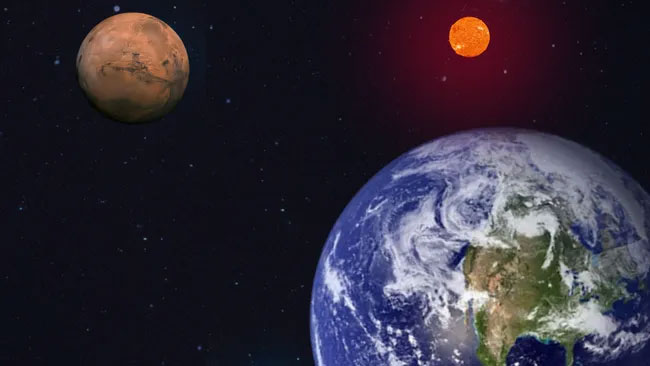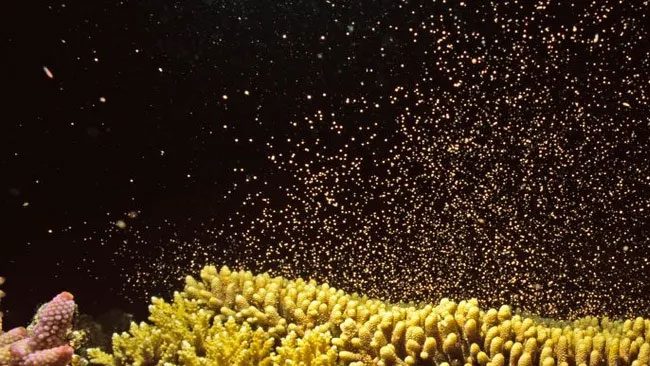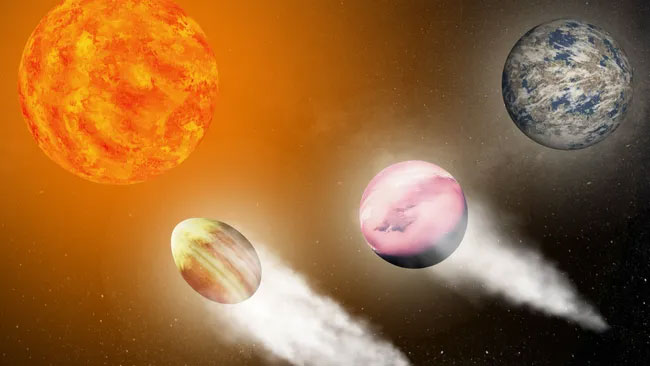Scientists have found geological evidence that the gravitational interaction between Mars and Earth is driving the 2.4-million-year deep-sea circulation cycle and global warming. What happens if the moon disappears? Stars can strip entire planets of their atmospheres. Discovery of retrograde orbits.
Mars influences the climate of the Earth and the sea
Scientists have found geological evidence that the gravitational interaction between Mars and Earth is driving the 2.4-million-year deep-sea circulation cycle and global warming.
A surprising connection between Mars and Earth’s seas and climate causes deep currents to wax and wane during periods of increased solar energy and warmer climates. The research could help clarify how climate change on geological timescales (rather than the kind humans are currently causing through greenhouse gas emissions) affects ocean circulation. According to members of the research team, this knowledge could help researchers create better climate models in the future, the journal reports in the journal Nature Communications.
A research team led by University of Sydney scientist Adriana Dutkiewicz began studying whether ocean currents become stronger or more sluggish as Earth’s climate warms. To do this, Dutkiewicz and his colleagues used half a century of scientific drilling data collected from hundreds of sites around the world. This data allowed them to understand how strong deep-sea currents have been over the past 50 years.
To go back in time—about 65 million years, almost to the age of the dinosaurs—they studied the Earth’s deep-sea sediment record. This allowed them to test whether changes in the Earth’s orbit were related to shifts in sedimentary rocks. The team discovered 2.4-million-year cycles, or “great astronomical cycles,” that are associated with the orbits of Earth and Mars.
“We were surprised to find these 2.4-million-year cycles in our deep-sea sediment data,” Dutkiewicz said. “There is only one way to explain them: they are related to the interaction cycles of Mars and Earth orbiting the Sun.”
Scientists have long known about astronomical great cycles, but they are rarely found in the geology of the Earth.

The illustration (not to scale) shows Mars and Earth orbiting the Sun. Robert Lee/NASA
Study co-author Dietmar Muller, also from the University of Sydney, explained how the orbits of Earth and Mars could cause shifts in the oceans.
“The gravitational fields of the solar system planets interfere with each other, and this interaction, called resonance, changes the planets’ eccentricity – a measure of how close to circular their orbits are,” he said.
On Earth, this led to periods when our planet received more solar radiation, thereby creating a warmer climate. The 2.4-million-year cycles contained “breaks” in the deep-sea record, and these breaks indicate periods of more vigorous ocean circulation.
The team’s results suggest that the circular movement of water, causing small eddies or “eddies” in the deep ocean, was an important factor in warming seas.
These eddies may have helped offset the ocean stagnation that many scientists predict will follow a slowdown in the Atlantic Meridional Overturn Circulation (AMOC). The AMOC is a vast system of ocean currents that carries warm water from the tropics to the North Atlantic Ocean. It is responsible for the movement of the Gulf Stream and maintaining a warm climate in Europe.
“We know that there are at least two separate mechanisms that promote vigorous mixing of deep water in the oceans. The AMOC is one of them, but deep ocean eddies appear to play an important role in warm climates by maintaining ocean ventilation.” – said Mueller. “Of course, it won’t have the same effect as the AMOC in terms of transporting water masses from low latitudes to high latitudes and vice versa.”
These eddies often reach the deep ocean floor, also known as the “abyssal seafloor.” Once these huge eddies connected to the deep seafloor, they could cause erosion and create large, drift-like accumulations of sediment called “contourites.”
“Our 65 million years of deep-sea data suggest that warmer oceans have more vigorous deep circulation,” Dutkiewicz concluded. “This will potentially prevent ocean stagnation even if the AMOC slows or stops altogether.”
The team doesn’t yet know how the interaction between the orbits of Earth and Mars and the ocean dynamics it creates might affect life in Earth’s oceans in the future. Regardless, the results could lead to more reliable climate modeling and forecasts.
What happens if the moon disappears?
The Moon was connected to the Earth for most of its 4.5 billion year orbit around the Sun. Astrophysicists suggest that the Moon’s origins lie in an ancient impact where an object the size of Mars crashed into our planet, sending huge amounts of debris into space. The resulting materials came together under the influence of gravity, forming what we now call the Moon.
We and the rest of life on Earth are so accustomed to the presence of the Moon that it is difficult to imagine what life on Earth would be like if our natural satellite suddenly disappeared. But could the Moon ever slip away or disappear? What happens if she disappears?
According to Noah Petro, a scientist on NASA’s Artemis 3 lunar mission, few realistic astronomical events could have caused such a dramatic event.
“I think the only plausible astronomical event that could unbind the Moon would be a strong impact on the Moon that would split it apart. … Similar to the large impact that is believed to have formed the Moon, a large enough object could theoretically break the Moon apart,” Petro said.
Fortunately, the Sun and planets have swallowed up most of the large objects in the solar system. A rogue planet entering the solar system from interstellar space could cause damage, but the likelihood of it colliding with the moon is extremely low, Petro said. But let’s say it happened that the Moon disappeared, and the Earth somehow remained relatively untouched.
In terms of physical processes, one of the most noticeable disturbances will be the impact on ocean tides, which are responsible for coastal ecosystems. Marine life in intertidal zones will either die or adapt, and we will likely see the collapse of key ecosystems that rely on intertidal zones for food sources. Nearly three-quarters of the world’s population lives within 31 miles (50 kilometers) of the ocean, and so billions of people either harvest or forage for food from intertidal zones. The collapse of this ecosystem would have catastrophic consequences for coastal communities.
In addition, tidal coastal erosion largely determines the shape of our coastlines. This process will slow down significantly, and the battle between land and sea will settle into a (somewhat) truce.

Corals use signals from the lunar cycle and ocean temperature to influence their spawning cycle. Here, hard coral (Acropora sp.) spawns in Lizard Island National Park, Great Barrier Reef, Queensland, Australia. Auscape/Universal Images Group
Tides also play an important role in the overall thermoregulation of the ocean. Colder, deeper ocean water is pulled into bays and inlets at high tide, where it warms up. Ocean tides also have a profound influence on stronger ocean currents and therefore ocean circulation. These currents also feed back, causing overlying winds that play an important role in regulating coastal climate. The sudden disappearance of the tidal forces that drive these mechanisms would have a huge impact on the spread of heat and energy across the planet, changing temperatures and climates to places we barely recognize.
One of the most profound effects of the Moon’s disappearance will take some time to manifest itself, but it will have enormous consequences. The Earth’s axis is currently at an angle of 23.4 degrees relative to our orbit of the Sun. However, there is oscillation in its rotation cycle. But it takes 26,000 thousand years to complete a full cycle, the deviation of which is only 2.4 degrees. Without the Moon to stabilize it, this wobble can become extreme and erratic. In this scenario, predictable seasons would disappear and the poles would sometimes end up aligned with the equator. The results will radically change the habitability of Earth, as the once predictable environment will become hostile to many forms of life.
Indeed, a number of species and ecosystems have developed a deep dependence on the physical consequences of the Moon. After all, life evolved thanks to the moon and its cycles as an important environmental condition. The life cycles or behavior of some species are based on the cycles of the moon. Some examples are bird species that rely on moonlight as a signal for migratory journeys. The timing of moonrise is also key to the synchronized spawning of corals on the Great Barrier Reef.

If an object as large as a rogue planet destroys the Moon, it is unlikely that the Earth will remain relatively intact
The moon is also a source of night light for nocturnal species, especially nocturnal predators. Evidence has shown that small mammals limit their activity during the high moon (when there is more light) due to the risk of predation. Without this light, the prey would have a serious advantage over their predatory opponents.
Humanity’s relationship with the Moon runs deep. Of course, the Moon was the first extraterrestrial body to be set foot on by humans, and its disappearance would greatly impact our space exploration goals. The Moon provides a tangible stepping stone for future astronomical journeys, where we can test our equipment and learn more about the history of the solar system without straying too far from home.
The Moon is a time capsule of the early solar system, Petro noted. By studying it, we can get an idea of how the Sun developed, the history of impacts on the lunar surface, and what it was like in the early stages of the solar system.
Stars exert gravitational “compression” on planets, depriving them of atmosphere
Tidal forces and radiation bombardment can cause some planetary atmospheres to leak into space. The scientist learned more about the processes that strip the atmosphere from planets, and discovered that compression by the parent star may contribute to this process.
The study, led by Guo Jianheng of the Yunnan Observatory of the Chinese Academy of Sciences, may help astronomers better determine which extrasolar planets, or “exoplanets,” should be studied more closely as they expand their search for life beyond the solar system.
There are several ways that planets can lose their atmosphere into space, including the upper atmosphere leaving the planet entirely, which is called “hydrodynamic escape.” This process is considered more extreme than the process by which planets in our solar system today eject particles into space through “hydrodynamic venting,” which causes the planet to lose mass while simultaneously affecting its climate and therefore its habitability.
Jianheng simulated the loss of atmosphere due to low-mass exoplanets. In particular, Jianheng focused on the mechanism of hydrodynamic atmospheric escape and proposed a new classification method that can be used to understand this and other atmospheric escape processes.
Although this no longer occurs with the inner planets around the Sun, in the early era of the Solar System, hydrodynamic escape of the atmosphere could actually occur with planets such as Venus and Earth. If this process continued, our planet might be left with only a thin, mostly waterless atmosphere, similar to the one we see around our planetary neighbor, Mars.
This means that understanding the hydrodynamic output of the atmosphere can help determine why Earth is capable of supporting life but Mars and Venus are not.

An illustration showing the mechanisms that can cause planets to lose their atmosphere. Guo Jianheng
Although hydrodynamic atmospheric ejection does not currently cause atmospheric destruction in the solar system, astronomers have used space and ground-based telescopes to determine that these processes do occur around exoplanets close to their parent stars.
Jianheng conducted computer simulations of low-mass exoplanets, which showed that planets with hydrogen-rich atmospheres can experience hydrodynamic atmospheric ejection as a result of internal energetic processes.
This energy manifests itself as internal heat and is generated by tidal forces that squeeze and compress the planet—forces caused by the gravity of the parent stars and the bombardment of intense ultraviolet radiation from those stars. Sometimes these forces can even deform planets, giving them an ovoid shape.
Modeling has previously been used to understand the physical mechanisms that cause hydrodynamic blowout, but these models were complex and often led to unclear conclusions.
Jianheng, on the other hand, argues that the physical parameters required to classify hydrodynamic output mechanisms are simple. According to the researcher, you just need to think about the characteristics of the planets and stars involved, such as their masses, radii, and the orbital distance between the planet and its star.
Jianheng’s simulations showed that for plumper, less dense exoplanets with low mass and large radius, sufficiently high internal temperatures could cause atmospheric leakage. The ratio of a planet’s internal energy to its gravitational potential energy, known as the “Jeans parameter”, can be used to determine whether a planet will experience atmospheric escape. The lower the Jeans parameter, the more likely it is that an atmospheric leak will occur.

The illustration shows three exoplanets at different distances around a star, experiencing different levels of radiation and gravitational forces that erode their atmospheres at different rates. Robert Lee
For planets that cannot experience hydrodynamic escape due to high internal energy, Jianheng found that a modified Jeans parameter that takes into account tidal forces generated by stars can identify and distinguish the role that these forces and extreme ultraviolet radiation play in atmospheric escape.
The simulations also showed that low-mass planets with high gravitational potential, resulting from the increasing distance between a planet and its star, as well as the lower radiation such a world would be bombarded with, result in slower hydrodynamic escape from the atmosphere.
The findings could help scientists better determine how the atmospheres of low-mass planets change over time, helping to build a more complete picture of the habitability of these worlds.
Why do all planets rotate in the same direction?
The solar system initially had an original direction of rotation and maintained it for 4.6 billion years. To force a planet to change its path around the Sun, something massive must force it into a changed orbit under the influence of its gravity.
Astronomers have discovered planets around other stars with retrograde orbits that move in the opposite direction to the rotation of their stars.
If you could go back 4.6 billion years, you would see a time when our solar system did not exist. But space wouldn’t be empty—instead of our Sun and planets, you’d be faced with a cloud of gas and dust. This “solar nebula” was once a rich source of gas and dust that formed our solar system. Nebulae are the end result of a star’s death throes, when the star explosively sheds all its material. They are also nurseries for new stars and their accompanying planets, and may help explain why our planets all spin in the same direction.
Our current explanation for the creation of the solar system is as follows: a shock wave from a nearby star that went supernova triggered the collapse of our solar nebula. When a nearby giant star exploded, high-energy particles exploded into the nebula, causing pockets of matter and gas to collapse.
This created a powerful gravitational center point around which the rest of the condensing cloud rotated. Pressure from the core caused hydrogen atoms to combine and form helium, releasing enormous amounts of heat and light, consuming more than 99 percent of the available matter in the cloud. The center of the collapsing nebula became our Sun, and the rest of the matter clumped together to form familiar planets, moons, and other rocky bodies such as asteroids.
As the solar nebula collapsed, the matter inside began to spin faster under its own gravity. Due to the conservation of angular momentum—the rate of rotation of an object around a central axis—the cloud’s rotation speed increased and it leveled off. Because the cloud initially rotated, the same direction of rotation was maintained. According to astronomers, for the most part the planets maintained their positions in the same orbital plane. Venus and Uranus experienced great turbulence at some point. Astronomers believe that the movements of Jupiter and Saturn, which also moved further away from the Sun, influenced these two smaller planets and changed their motion.
The initial direction of rotation was random. When looking at the Sun’s north pole from above, the solar system’s orbital plane could begin to rotate either clockwise or counterclockwise. It turns out that we all travel around the sun counterclockwise, but there’s nothing special about it.
Our planets (and their accompanying moons) orbit the Sun in the same direction in which the Sun rotates. However, some comets and asteroids do move around the Sun in retrograde orbits—as opposed to the Sun’s rotation—because their relatively low mass allows larger space objects to more easily steer them away from their original direction.
Changing a planet’s orbit would require a huge expenditure of energy or a close encounter with another planet. Alternatively, a distant planet-sized object in space could exert its own gravitational force to counteract its host star. For example, the exoplanet Kepler-2b, a gas giant orbiting a star more than 1,040 light-years away, may have been put into a tilted and elongated orbit by a strong gravitational force, perhaps from another planet. The tilt actually flipped Kepler-2b’s orbit. Jupiter did something similar to the asteroids in our solar system. Neptune’s moon Triton, Saturn’s moon Phoebus and the karmic moons of Jupiter also have retrograde orbits around their planets.




